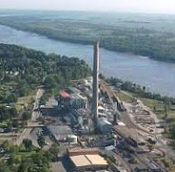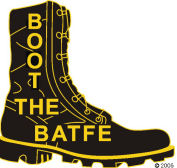

It's the end of the primary lead smelter
in Herculaneum (and I feel fine)
![]()
(We ran an earlier article on this subject
"Back Door Gun Control Moves Forward", on 11/2/13).
By Bob Owens, November 8th, 2013
Article Source
 In recent days various news outlets, blogs, and forums have gotten very worked up over the closure of the nation's last primary lead smelter in Herculaneum, Missouri. Many are claiming that this is an attempt of the Obama Administration to implement "backdoor gun control" by destroying the lead used as the primary metal in most bullets and shot used by the ammunition industry.
In recent days various news outlets, blogs, and forums have gotten very worked up over the closure of the nation's last primary lead smelter in Herculaneum, Missouri. Many are claiming that this is an attempt of the Obama Administration to implement "backdoor gun control" by destroying the lead used as the primary metal in most bullets and shot used by the ammunition industry.
This is simply untrue.
Despite the hysteria to the contrary, the primary smelter in Herculaneum has almost no direct impact on the U.S. ammunition market. Pure lead, in fact, is not desirable for the creation of ammunition as it is too soft. Pure lead is primarily used in the creation of low-contamination specialty products.
Where does all the lead in the U.S. go? The eggheads at the US. Geological Survey state:
By the early 2000s, the total demand for lead in all types of lead-acid storage batteries represented 88% of apparent U.S. lead consumption. Other significant uses included ammunition (3%), oxides in glass and ceramics (3%), casting metals (2%), and sheet lead (1%). The remainder was consumed in solders, bearing metals, brass and bronze billets, covering for cable, caulking lead, and extruded products.
According to Daniel Hill, Operations Manager at Mayco Industries—"the largest fabricator of lead based products, other than batteries, in the United States" including lead shot and the lead wire used by many bullet manufacturers— roughly validates these numbers. Hill said that least 80% of lead used in the United States secondary market comes from recycled batteries and another 7%-9% of lead on the market comes from other scrap sources. Only 10% of the lead in the U.S. comes from mining.
 Translated into plain English, ammunition isn't a primary lead consumer (3%) in the United States, and the majority of the lead used by ammunition manufacturers comes from secondary smelters that recycle lead from car batteries.
Translated into plain English, ammunition isn't a primary lead consumer (3%) in the United States, and the majority of the lead used by ammunition manufacturers comes from secondary smelters that recycle lead from car batteries.
Sierra Bullets confirmed earlier this week that they have never used lead from a primary smelter.
Tim Brandt of ATK (Federal Premium, CCI, and Speer ammunition), noted that they had just added this to the top of their frequently asked questions (FAQ).
Q: Does the recent news regarding a major U.S. lead smelter shutting down mean you'll have trouble obtaining lead for manufacturing conventional ammunition?
A: At this time we do not anticipate any additional strain on our ability to obtain lead.
 Brad Alpert, President and Operations Manager of Missouri Bullet Company, was even more blunt, calling fears of a shortage a "tempest in a teapot," stating that the closure of the primary smelter have "no impact" on their production.
Brad Alpert, President and Operations Manager of Missouri Bullet Company, was even more blunt, calling fears of a shortage a "tempest in a teapot," stating that the closure of the primary smelter have "no impact" on their production.
David Hargett, CEO of new North Carolina-based ammunition manufacturer Cape Fear Arsenal considers the closure of the primary smelter a "non-issue."
In summary, the closure of the Doe Run primary smelter will have little to no impact on the ability of ammunition companies to produce bullets, because they have no direct interest in the consumption of "pure lead" produced by a primary smelter.
The ammunition companies we were able to speak with obtain the lead wire they use in the creation of bullets from secondary smelters and foundries that create lead alloys made from recycled lead from batteries and other scrap sources.
It's the end of the nation's last operating primary lead smelter, but not close to seeing the end of lead ammunition manufactured in the United States, nor are we seeing an attempt at backdoor gun control.
Author: Bob Owens:
Bob Owens is the Editor of BearingArms.com. A long-time shooting enthusiast, he began blogging as a North Carolina native in New York at the politics-focused Confederate Yankee in 2004. In 2007 Bob began writing about firearms, gun rights, and crime at Pajamas Media, and added gun and gear reviews for Shooting Illustrated in 2010. He is a volunteer in the Appleseed Project, where he shares stories of our shared American heritage and teaches traditional rifle marksmanship. His personal blog is bob-owens.com, and he can be found on Twitter at bob_owens.
![]()




































